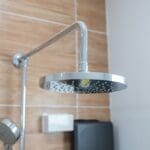Ever found yourself crouching under a too-low shower head, wondering if there’s a better way? You’re in luck because elevating your shower head for a superior wash is simpler than you might think.
Key Takeaways
- Assess your current shower setup and consider raising or replacing the shower head.
- Gather the necessary tools and materials for the installation process.
- Properly remove the existing shower head to avoid damaging the plumbing.
- Install an extension arm to raise the shower head and test the water flow.
Assess Your Current Setup
Before considering any adjustments, it’s essential to evaluate the height and water flow of your current shower head. To start, you’ll want to check the water pressure. This can be done by removing the old shower head and carefully turning on the water to observe the flow. If the pressure seems low, it mightn’t just be your shower head that’s the issue. You should also check the main valve to ensure it’s fully open, as this can significantly impact water pressure throughout your home.
If after these steps you find the pressure in the shower remains less than ideal, then raising your shower head or replacing it might be the next steps. A higher shower arm can help increase water pressure by reducing bends and restrictions in water flow. Additionally, newer shower heads are designed to optimize water flow, which can also increase pressure.
To raise your shower head, you’ll need to remove the old one carefully. This process involves unscrewing the old shower head from the shower arm. Once removed, you can replace it with an extended shower arm to elevate the height of your shower head, potentially improving water flow and pressure in the shower.
Gather Necessary Tools
Having assessed your shower’s current setup and decided on raising the shower head, it’s crucial to gather the necessary tools for the job. This step ensures a smooth installation process, whether you’re aiming to simply elevate the existing shower head, install a new one, or upgrade to a handheld shower head for enhanced flexibility and shower water pressure.
Before starting, make sure you have:
- An S-pipe and Teflon tape to ensure a secure and leak-proof connection.
- A new shower head or handheld shower head, if you’re looking to upgrade. Double-check its compatibility with your shower hose and plumbing system.
- A crescent wrench for adjusting fittings and a toothbrush for cleaning any old residues from the fittings.
Consider upgrading your shower head for a better washing experience, but remember to verify the size and compatibility of the S-pipe and new shower head with your current setup. If the installation seems daunting or if compatibility issues arise, don’t hesitate to call a plumber. Hiring a professional can save you time and ensure your plumbing system remains intact.
Remove Existing Shower Head
First, ensure the water supply to your shower is turned off to begin the process of removing the existing shower head. This critical step prevents any unexpected water flow and allows you to work safely. Typically, you’ll find the main valve that controls the water lines to your shower in a utility closet or basement. Once the water is securely off, you’re ready to proceed.
Next, grab a pair of pliers or an adjustable wrench to unscrew the shower head from the shower arm. To avoid scratching the finish, wrap a cloth around the shower arm while you apply gentle force. If the shower head is stuck, don’t yank or pull too hard, as this could damage the plumbing. Instead, apply steady pressure to loosen it.
As you remove the existing shower head, keep an eye out for any washers or O-rings. These small parts are crucial for a watertight seal when you reinstall the showerhead. Losing them could lead to leaks or a reduced flow rate, impacting the gallons per minute your shower can deliver and potentially obstructing individual spray openings with a misplaced flow restrictor.
Install Extension Arm
After removing your old shower head, attach the adjustable shower head extension arm to the shower arm pipe to begin the installation process. This simple step is crucial for elevating your entire shower experience. Using an adjustable wrench or pliers, you can tighten the connection, ensuring a secure fit that prevents any potential leaks.
Once the extension arm is in place, it’s time to adjust the height. Raise or lower the extension arm to find your ideal position, enhancing comfort and functionality in your shower.
- Secure Tightening: Make sure the extension arm is firmly tightened against the pipe in the wall. A secure fit is essential to prevent water from leaking out where it shouldn’t.
- Height Adjustment: Find the perfect height for your shower head, allowing you to enjoy a more comfortable and efficient wash.
- Water Pressure Check: After reinstalling the shower head onto the extension arm, test the water flow. You might notice an improvement in water pressure, especially if you were experiencing low water pressure issues before.
Installing an extension arm not only raises your shower head but can also help increase the water pressure, making your showers more pleasant. This adjustment ensures that your entire shower head works efficiently, offering a better wash with an optimized flow of water.
Test and Adjust
To accurately assess your shower’s efficiency, start by testing the flow rate with a five-gallon bucket. Turn on the shower and fill the bucket, timing how long it takes. This will give you a clear picture of the current flow rate and if adjustments are necessary.
If the flow rate is low, it might indicate a need to replace the shower head or address issues in the water pipes that reduce the flow.
Ensure all water-using appliances and fixtures are off, as running these can affect water pressure in your shower. Showering during off-peak hours can also avoid high-demand periods, maintaining a steadier water pressure.
Inspect all valves to ensure they’re fully open, allowing maximum water flow. A partially closed valve can significantly lower water pressure.
Additionally, check the shower hose for any kinks or damage. A compromised hose can restrict water flow, and replacing it might restore your shower to its optimal performance.
Frequently Asked Questions
What Is the Easiest Way to Raise a Shower Head?
To easily raise your shower head, you’ll need an adjustable extension arm. Simply unscrew the current head, attach the extension, then reattach the head. It’s a quick, tool-free way to adjust the height.
How Can I Make My Shower Head Run Better?
To make your shower head run better, check its flow rate and ensure full water flow by turning off other appliances. Shower during off-peak hours, fully open valves, and unkink or replace the hose.
How Do I Make My Shower Head High Flow?
To make your shower head high flow, choose a high-flow model, remove any restrictors, clean it regularly, ensure valves are fully open, and consider upgrading your plumbing for better pressure and a superior shower experience.
Why Is My Shower Head so Low?
Your shower head might be low due to clogged nozzles, a twisted hose, or low water pressure. Check for blockages, straighten out the hose, and ensure valves are fully open for better flow.





